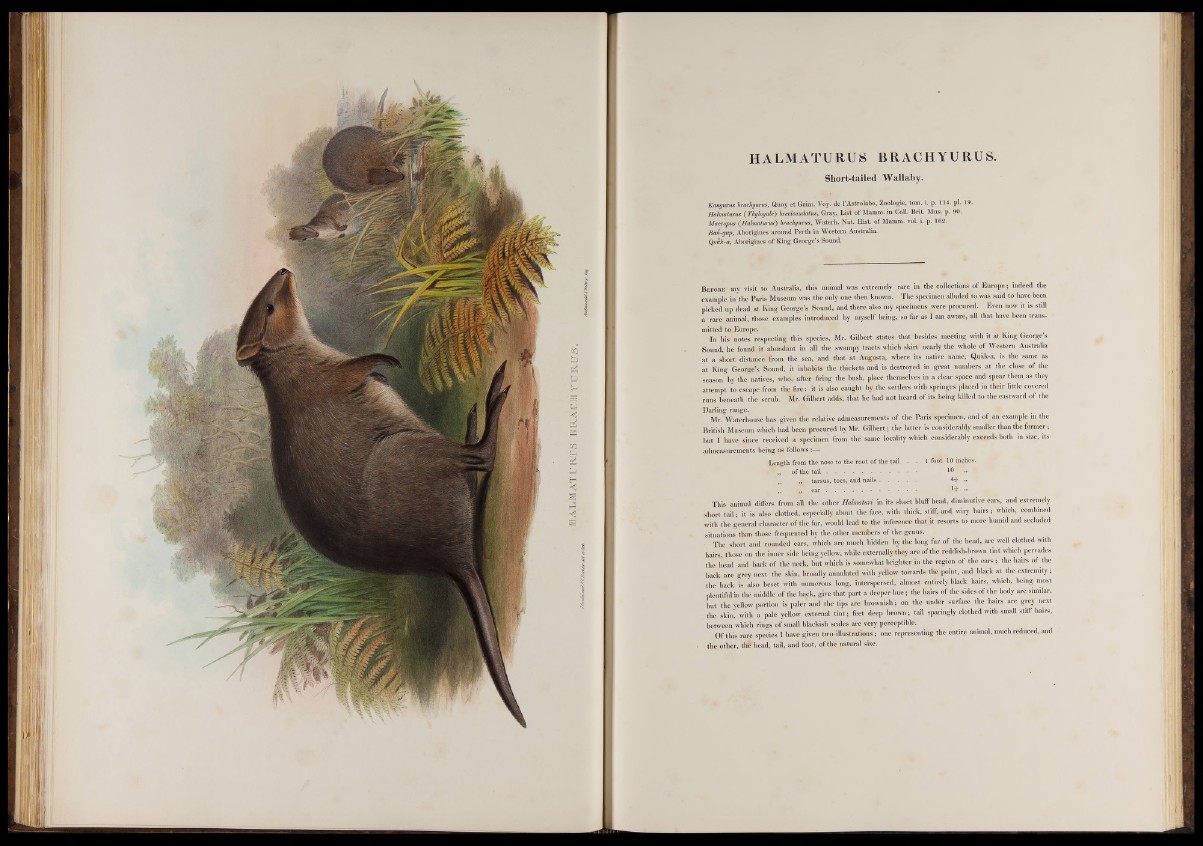
H A IM A T ü H fS ' B R A C IY U R U S .
HALMATURUS BRACHYURUS.
Short-tailed Wallaby.
Kangurua brachyurm, Quoy et Gaim. Voy. de V Astrolabe, Zoologie, tom. i. p. 114. pi. 19.
Halinaturus ( ThyloyaU) brevicaudatus, Gray, List of Mamm. in Coll. Brit. Mus. p. 90.
Macropus (Habnaturus) brachyurus, Waterh. Nat. Hist, of Mamm. vol. i. p. 162.
Ban-gup, Aborigines around Perth in Western Australia.
Quak-a, Aborigines of King George’s Sound.
Before my visit to Australia, this animal was extremely rare in the collections of Europe; indeed the
example in the Paris Museum was the only one then known. The specimen alluded to was said to have been
picked up dead at King George’s Sound, and there also my specimens were procured. Even now it is still
a rare animal, those examples introduced by myself being, so far as I am aware, all that have been transmitted
to Europe. vs.
In his notes respecting this species, Mr. Gilbert states that besides meeting with it at King George’s
Sound, he found it abundant in all the swampy tracts which skirt nearly the whole of Western Australia
at a short distancé from the sea, and that at Augusta, where its native, name, Quak-a, is the same as
at King George’s Sound, i t inhabits the thickets and is destroyed in great numbers at the close of the
season hy the natives, who, after firing the bush, place themselves in a clear space and spear them as they
attempt to escape from the fire; it is also caught by the settlers with springes placed in their little covered
runs beneath the scrub. Mr. Gilbert adds, that he had not heard of its being killed to the eastward Of the
Darling range.
Mr. Waterhouse has given the relative admeasurements of the Paris specimen, and of an example in the
British Museum which had been procured hy Mr. Gilbert ; the latter is considerably smaller than the former ;
but I have since received a specimen from the same locality which considerably exceeds both in size, its
admeasurements being as follows :—
Length from the nose to the root of the tail . . 1 foot 10 inches,
of the tail 1° »
tarsus, toes, and n a ils .... ^ „
„ ,, e a r ....................................... ** »
This animal differs from all the other Halmaturi in its short bluff head, diminutive ears, and extremely
short tail ; it is also clothed, especially about the face, with thick, stiff, and wiry hairs ; which, combined
with the general character of the fur, would lead to the inference that it resorts to more humid and secluded
situations than those frequented by the other members of the genus.
The short and rounded ears, which a ri much hidden by the long fur of the head, are well clothed with
hairs, those on the inner side being yellow, while externally they are of the reddish-brown tint which pervades
the head and back of the neck, hut which is somewhat brighter in the region of the ears ; the hairs of the
hack are grey next the skin, broadly annulated with yellow towards the point, and black at the extremity ;
the back is also beset with numerous long, interspersed, almost entirely black hairs, which, being most
plentiful in the middle of the back, give that part a deeper hue ; the hairs of the sides of the body are simdar,
hut the yellow portion is paler and the tips are brownish ; on the under surface the hairs are grey next
the skin, with a pale yellow external tint; feet deep brown; tail s p a r i n g l y clothed with small stiff hairs,
between which rings of small blackish scales are very perceptible.
Of this rare species I have given two illustrations ; one representing the entire animal, much reduced, and
the other, th? head, tail, and foot, of the natural size.